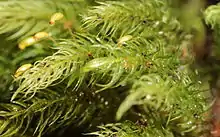| Rhizogoniales | |
|---|---|
 | |
| Pyrrhobryum parramattense | |
| Scientific classification | |
| Kingdom: | Plantae |
| Division: | Bryophyta |
| Class: | Bryopsida |
| Subclass: | Bryidae |
| Superorder: | Bryanae |
| Order: | Rhizogoniales (M. Fleisch.) Goffinet & W.R. Buck |
| Families | |
| Synonyms | |
| |
Description
Most of the taxa within the order are basal-branching pleurocarps.[2]
Taxonomy
Three families are included in the order. These are the Rhizogoniaceae, Orthodontiaceae, and Aulacomniaceae.[3]
References
- ↑ Bell, Neil E.; Quandt, Dietmar; O'Brien, Terry J.; Newton, Angela E. (2007). "Taxonomy and Phylogeny in the Earliest Diverging Pleurocarps: Square Holes and Bifurcating Pegs". The Bryologist. 110 (3): 533–560. doi:10.1639/0007-2745(2007)110[533:TAPITE]2.0.CO;2. JSTOR 20110887. S2CID 86255061.
- ↑ Newton, Angela E.; Tangney, Raymond S. (2007). Pleurocarpous Mosses: Systematics and Evolution. CRC Press. p. 299. ISBN 978-1-4200-0559-2.
- ↑ Buck, William R.; Goffinet, Bernard (2000). "Morphology and classification of mosses". In Shaw, A. Jonathan; Goffinet, Bernard (eds.). Bryophyte Biology. pp. 71–123. doi:10.1017/CBO9781139171304.004. ISBN 978-0-521-66794-4.
This article is issued from Wikipedia. The text is licensed under Creative Commons - Attribution - Sharealike. Additional terms may apply for the media files.